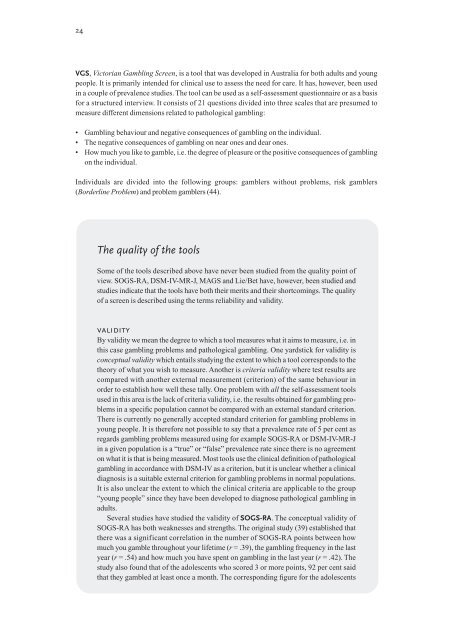Gambling Among Young People, 837 kB
Gambling Among Young People, 837 kB
Gambling Among Young People, 837 kB
Create successful ePaper yourself
Turn your PDF publications into a flip-book with our unique Google optimized e-Paper software.
24<br />
VGS, Victorian <strong>Gambling</strong> Screen, is a tool that was developed in Australia for both adults and young<br />
people. It is primarily intended for clinical use to assess the need for care. It has, however, been used<br />
in a couple of prevalence studies. The tool can be used as a self-assessment questionnaire or as a basis<br />
for a structured interview. It consists of 21 questions divided into three scales that are presumed to<br />
measure different dimensions related to pathological gambling:<br />
• <strong>Gambling</strong> behaviour and negative consequences of gambling on the individual.<br />
• The negative consequences of gambling on near ones and dear ones.<br />
• How much you like to gamble, i.e. the degree of pleasure or the positive consequences of gambling<br />
on the individual.<br />
Individuals are divided into the following groups: gamblers without problems, risk gamblers<br />
(Borderline Problem) and problem gamblers (44).<br />
The quality of the tools<br />
Some of the tools described above have never been studied from the quality point of<br />
view. SOGS-RA, DSM-IV-MR-J, MAGS and Lie/Bet have, however, been studied and<br />
studies indicate that the tools have both their merits and their shortcomings. The quality<br />
of a screen is described using the terms reliability and validity.<br />
validity<br />
By validity we mean the degree to which a tool measures what it aims to measure, i.e. in<br />
this case gambling problems and pathological gambling. One yardstick for validity is<br />
conceptual validity which entails studying the extent to which a tool corresponds to the<br />
theory of what you wish to measure. Another is criteria validity where test results are<br />
compared with another external measurement (criterion) of the same behaviour in<br />
order to establish how well these tally. One problem with all the self-assessment tools<br />
used in this area is the lack of criteria validity, i.e. the results obtained for gambling problems<br />
in a specific population cannot be compared with an external standard criterion.<br />
There is currently no generally accepted standard criterion for gambling problems in<br />
young people. It is therefore not possible to say that a prevalence rate of 5 per cent as<br />
regards gambling problems measured using for example SOGS-RA or DSM-IV-MR-J<br />
in a given population is a “true” or “false” prevalence rate since there is no agreement<br />
on what it is that is being measured. Most tools use the clinical definition of pathological<br />
gambling in accordance with DSM-IV as a criterion, but it is unclear whether a clinical<br />
diagnosis is a suitable external criterion for gambling problems in normal populations.<br />
It is also unclear the extent to which the clinical criteria are applicable to the group<br />
“young people” since they have been developed to diagnose pathological gambling in<br />
adults.<br />
Several studies have studied the validity of SOGS-RA. The conceptual validity of<br />
SOGS-RA has both weaknesses and strengths. The original study (39) established that<br />
there was a significant correlation in the number of SOGS-RA points between how<br />
much you gamble throughout your lifetime (r = .39), the gambling frequency in the last<br />
year (r = .54) and how much you have spent on gambling in the last year (r = .42). The<br />
study also found that of the adolescents who scored 3 or more points, 92 per cent said<br />
that they gambled at least once a month. The corresponding figure for the adolescents

















